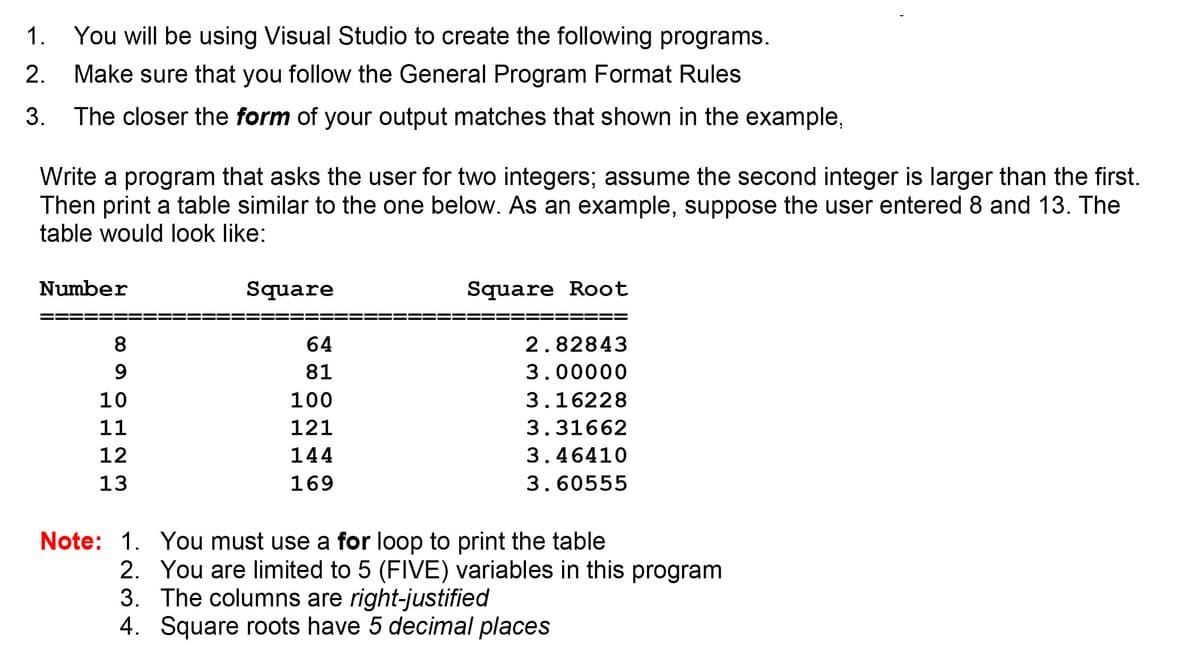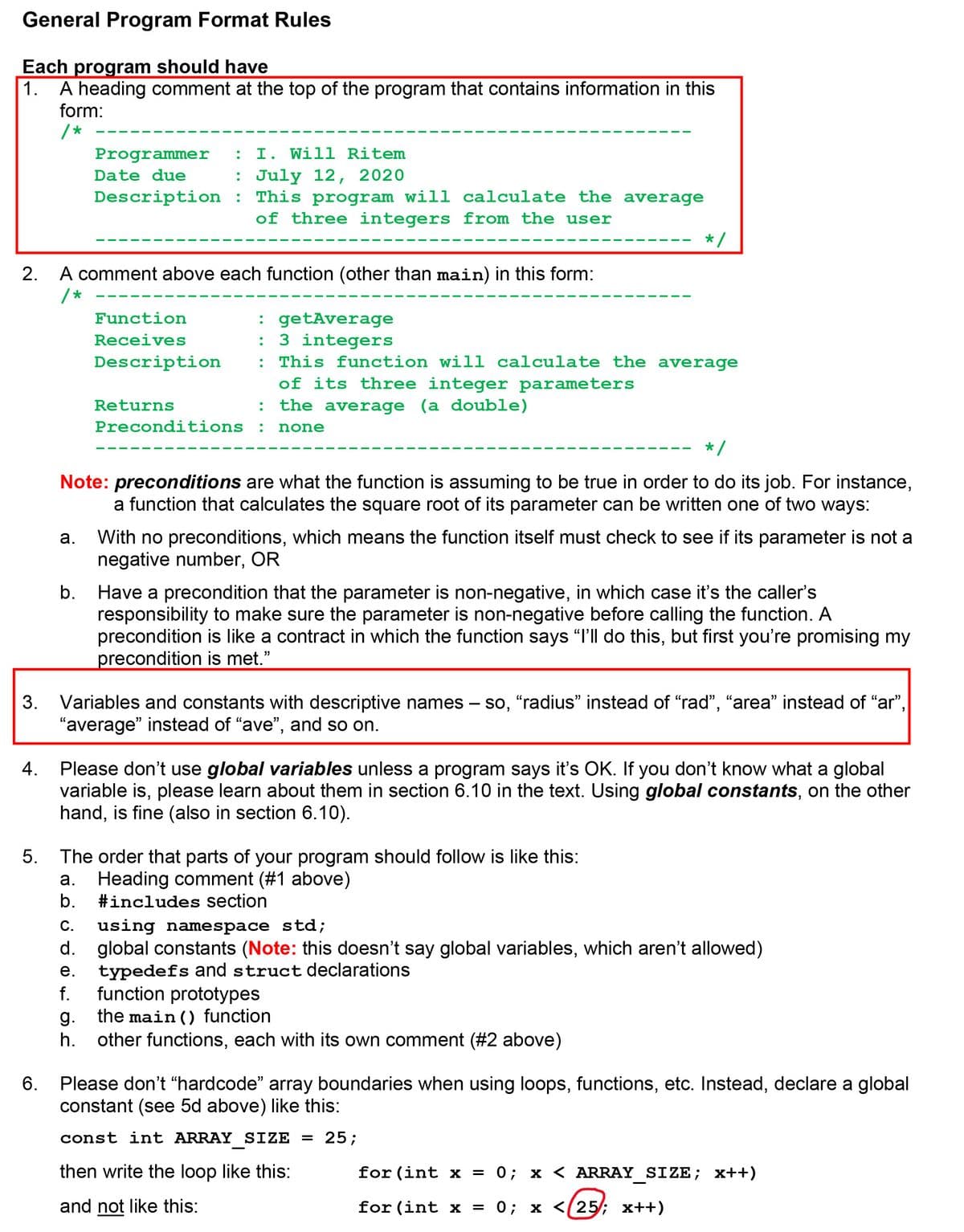Write a program that asks the user for two integers; assume the second integer is larger than the first. Then print a table similar to the one below. As an example, suppose the user entered 8 and 13. The table would look like: Number Square Square Root === == 8 64 2.82843 9. 81 3.00000 10 100 3.16228 11 121 3.31662 12 144 3.46410 13 169 3.60555
Write a program that asks the user for two integers; assume the second integer is larger than the first. Then print a table similar to the one below. As an example, suppose the user entered 8 and 13. The table would look like: Number Square Square Root === == 8 64 2.82843 9. 81 3.00000 10 100 3.16228 11 121 3.31662 12 144 3.46410 13 169 3.60555
Chapter6: Using Arrays
Section: Chapter Questions
Problem 3E
Related questions
Question
Hi, I need to answer this question using the C++
Note: I have included a copy of the General Program Format Rules.

Transcribed Image Text:1. You will be using Visual Studio to create the following programs.
2.
Make sure that you follow the General Program Format Rules
3. The closer the form of your output matches that shown in the example,
Write a program that asks the user for two integers; assume the second integer is larger than the first.
Then print a table similar to the one below. As an example, suppose the user entered 8 and 13. The
table would look like:
Number
Square
Square Root
8
64
2.82843
81
3.00000
10
100
3.16228
11
121
3.31662
12
144
3.46410
13
169
3.60555
Note: 1. You must use a for loop to print the table
2. You are limited to 5 (FIVE) variables in this program
3. The columns are right-justified
4. Square roots have 5 decimal places

Transcribed Image Text:General Program Format Rules
Each program should have
1. A heading comment at the top of the program that contains information in this
form:
/*
Programmer
I. Will Ritem
:
Date due
: July 12, 2020
Description : This program will calculate the average
of three integers from the user
*/
A comment above each function (other than main) in this form:
/ *
: getAverage
: 3 integers
: This function will calculate the average
of its three integer parameters
: the average (a double)
Function
Receives
Description
Returns
Preconditions : none
* /
Note: preconditions are what the function is assuming to be true in order to do its job. For instance,
a function that calculates the square root of its parameter can be written one of two ways:
With no preconditions, which means the function itself must check to see if its parameter is not a
negative number, OR
а.
b. Have a precondition that the parameter is non-negative, in which case it's the caller's
responsibility to make sure the parameter is non-negative before calling the function. A
precondition is like a contract in which the function says "Ill do this, but first you're promising my
precondition is met."
3. Variables and constants with descriptive names
"average" instead of "ave", and so on.
– so, "radius" instead of "rad", "area" instead of "ar",
Please don't use global variables unless a program says it's OK. If you don't know what a global
variable is, please learn about them in section 6.10 in the text. Using global constants, on the other
hand, is fine (also in section 6.10).
4.
The order that parts of your program should follow is like this:
Heading comment (#1 above)
b.
а.
#includes section
using namespace std;
d.
C.
global constants (Note: this doesn't say global variables, which aren't allowed)
typedefs and struct declarations
f.
е.
g.
h.
function prototypes
the main () function
other functions, each with its own comment (#2 above)
6.
Please don't "hardcode" array boundaries when using loops, functions, etc. Instead, declare a global
constant (see 5d above) like this:
const int ARRAY SIZE = 25;
then write the loop like this:
for (int x
= 0; x < ARRAY SIZE; x++)
and not like this:
for (int x = 0; x <(25/; x++)
2.
5.
Expert Solution
This question has been solved!
Explore an expertly crafted, step-by-step solution for a thorough understanding of key concepts.
This is a popular solution!
Trending now
This is a popular solution!
Step by step
Solved in 2 steps with 2 images

Knowledge Booster
Learn more about
Need a deep-dive on the concept behind this application? Look no further. Learn more about this topic, computer-science and related others by exploring similar questions and additional content below.Recommended textbooks for you

Microsoft Visual C#
Computer Science
ISBN:
9781337102100
Author:
Joyce, Farrell.
Publisher:
Cengage Learning,

EBK JAVA PROGRAMMING
Computer Science
ISBN:
9781337671385
Author:
FARRELL
Publisher:
CENGAGE LEARNING - CONSIGNMENT

EBK JAVA PROGRAMMING
Computer Science
ISBN:
9781305480537
Author:
FARRELL
Publisher:
CENGAGE LEARNING - CONSIGNMENT

Microsoft Visual C#
Computer Science
ISBN:
9781337102100
Author:
Joyce, Farrell.
Publisher:
Cengage Learning,

EBK JAVA PROGRAMMING
Computer Science
ISBN:
9781337671385
Author:
FARRELL
Publisher:
CENGAGE LEARNING - CONSIGNMENT

EBK JAVA PROGRAMMING
Computer Science
ISBN:
9781305480537
Author:
FARRELL
Publisher:
CENGAGE LEARNING - CONSIGNMENT

Programming Logic & Design Comprehensive
Computer Science
ISBN:
9781337669405
Author:
FARRELL
Publisher:
Cengage